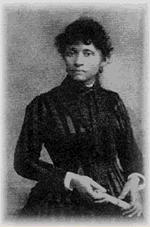

|
Albert Richard Parsons (1848-1887) Albert Richard Parsons, radical labor organizer, was born in Montgomery, Alabama, on June 24, 1848, the youngest child of Samuel and Elizabeth (Tompkins) Parsons. Both parents died before he was five, and Albert was sent to Tyler, Texas, to live with his brother William Henry Parsons. From 1855 until 1859 the family ranched in Johnson County, Texas, and from there they moved to Waco. In 1860 Albert Parsons was apprenticed to Willard Richardson on the Galveston Daily News. When the Civil War began, Parsons joined the Lone Star Grays, a Confederate volunteer company. Later he served as powder monkey for an artillery unit at Sabine Pass. In the final years of the war he was a scout for Parsons's Brigade. Following the war Parsons returned to Waco, where he received his only formal education, studying political economy and moral philosophy for six months at Waco University (now Baylor University). In 1867 he began to publish the Spectator, in which he advocated civil rights for Blacks and acceptance of the terms of surrender. He became a Radical Republican and traveled throughout Central Texas registering freed slaves to vote. The Republicans appointed him to a position in the district clerk's office in Waco in 1870; he was also appointed assistant assessor of United States revenue and was elected a secretary of the Texas Senate in 1871. When Reconstruction came to an end in Texas, Parsons was hated as a miscegenationist, a scalawag, a traitor, and a revenue man. He had been shot in the leg, thrown downstairs, beaten, and threatened with lynching for his efforts to register Black voters. That year, he moved to Chicago with his wife Lucy E. Parsons, a woman of mixed racial heritage, whom he had married in Austin in 1872. They had two children. In March 1876 Parsons became a member of the Social Democratic party of North America, and on July 4, 1876, he joined the Knights of Labor. He became a leading agitator for social change in Chicago, and the railroad strikes of July 1877 brought him into the limelight. He was taken to City Hall to face members of the powerful Citizens' Association, and he was fired from his job as a typesetter at the Chicago Times and blacklisted. The police chief warned him that his life was in danger and advised him to leave Chicago at once. After a series of defeats as a candidate for public office between 1877 and 1882, Parsons rejected electoral politics and joined radical trade unionists who advocated industrial struggle and believed unions to be the embryo of a postrevolutionary society. Parsons began to call himself an anarchist, although he used the terms anarchist and socialist interchangeably. Though his rhetoric was visionary and even violent at times, he remained committed to improved living conditions for all. To that end he helped to organize the Chicago Trades and Labor Council and threw himself into agitation for the eight-hour working day. In October 1884 he became editor of the Alarm, published by the International Working People's Association. May 1, 1886, the date set for the inauguration of the eight-hour day, passed smoothly and with great optimism; Lucy and Albert Parsons led a march of 80,000 strikers and supporters up Michigan Avenue. However, violence erupted two days later at the McCormick Reaper plant, and the anarchists called a meeting for the night of May 4 in Haymarket Square to protest police brutality. Parsons spoke, then left the meeting with Lucy and the two children; they were nearby in Zepf's Hall when nearly 200 policemen marched into the square; an unknown person threw a bomb, and police began shooting wildly. Most of the seven police officers and seven members of the crowd who died apparently sustained wounds from police revolvers. Albert Parsons left the city that night; in the aftermath of the bloodshed known radicals were jailed. Parsons returned to Chicago voluntarily and presented himself to the court, declaring his innocence and expecting to be exonerated. Ten men were indicted for conspiracy to murder, among them Parsons. Although the bomb-thrower was unknown, the prosecutors held that the defendants were guilty of conspiracy on the grounds that their speeches and writings might have inspired someone to throw the bomb. Of the eight men who stood trial, all were convicted, and seven, including Parsons, were sentenced to death. The defendants appealed to the Illinois Supreme Court, which upheld the verdict of the lower court. On November 2, 1887, the United States Supreme Court refused to hear the case. Parsons refused to appeal to the governor for clemency, declaring himself innocent and demanding his freedom. Governor Richard J. Oglesby commuted the sentences of two defendants to life imprisonment after they appealed for mercy, and the consensus of historians is that the governor would have spared Parsons's life had he appealed. On November 11, 1887, Parsons was hanged with the three comrades whom he refused to desert. Six years later, Governor John Peter Altgeld pardoned the three defendants who remained in prison and condemned the convictions as a miscarriage of justice. |